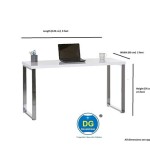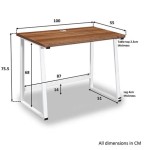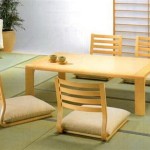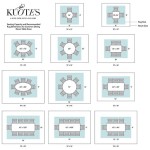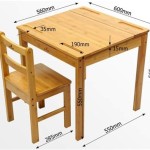Determining the Optimal Rug Size for a Round Dining Table
Selecting the correct rug size for a round dining table is crucial for both aesthetic appeal and functional comfort within a dining space. A well-chosen rug anchors the table, defines the dining area, and provides a comfortable surface underfoot. Conversely, an improperly sized rug can disrupt the room's flow, create a visually disjointed appearance, and hinder the usability of the dining space.
Several factors influence the ideal rug size, including the diameter of the table, the dimensions of the room, and the desired aesthetic. Careful consideration of these elements will ensure that the rug complements the table and enhances the overall dining experience. This article outlines the essential considerations for determining the appropriate rug size for a round dining table.
Understanding the 24-Inch Rule
The foundational principle for rug sizing under dining tables, regardless of shape, is the 24-inch rule. This guideline dictates that the rug should extend at least 24 inches beyond the perimeter of the table on all sides. This extension allows diners to comfortably pull out their chairs without the back legs falling off the rug, preventing instability and potential damage to the flooring. The 24-inch measurement accounts for standard chair dimensions and the typical space required for comfortable egress and ingress.
For a round table, the 24-inch rule translates to adding 48 inches to the table's diameter to determine the minimum recommended rug diameter. For example, a 48-inch diameter round table necessitates a rug with a minimum diameter of 96 inches (48 inches + 48 inches). Rounding up to the nearest standard rug size, in this case, likely an 8-foot round rug (96 inches), is generally advisable to ensure ample coverage. While the 24-inch rule is a guideline, it serves as a practical minimum to ensure chair stability and prevent the rug from looking disproportionately small.
Deviating from this rule can compromise the functionality and aesthetics of the dining area. A rug that is too small will cause chairs to wobble when pulled out, potentially scratching the floor and creating an uncomfortable dining experience. Furthermore, a small rug can visually shrink the dining area, making it appear cramped and disjointed. Adhering to the 24-inch rule, or exceeding it slightly, ensures a balanced and functional dining space.
While adhering to the 24-inch rule is essential, it's important to consider any potential obstructions or limitations within the room. If the dining area is confined or features architectural elements like built-in cabinets or doorways, adjustments to the rug size may be necessary to prevent overcrowding or interference with movement. In such cases, prioritizing the functionality and flow of the space is paramount.
Calculating the Optimal Rug Size Based on Table Diameter
The following provides specific guidelines for selecting rug sizes based on common round dining table diameters. These recommendations are based on the 24-inch rule and take into account standard rug sizes readily available on the market.
For a 36-inch Round Table: A 36-inch diameter table is best paired with a rug that is at least 84 inches in diameter (36 inches + 48 inches). A 7-foot round rug (84 inches) is the ideal minimum, but an 8-foot round rug (96 inches) may be preferred for a more generous extension and a more visually balanced appearance. A larger rug also provides more cushioning and sound absorption.
For a 48-inch Round Table: A 48-inch diameter table requires a rug that is at least 96 inches in diameter (48 inches + 48 inches). An 8-foot round rug (96 inches) is the standard recommendation. However, if the dining area is spacious, a 9-foot round rug (108 inches) could be considered for an even more luxurious and immersive feel. This provides ample space for chairs to be fully extended without leaving the rug's surface.
For a 60-inch Round Table: A 60-inch diameter table benefits from a rug that is at least 108 inches in diameter (60 inches + 48 inches). A 9-foot round rug (108 inches) is the minimum size recommended. In a larger dining room, a 10-foot round rug (120 inches) or even a 12-foot round rug (144 inches) could be used to create a more defined and visually impressive dining area. The choice depends on the overall dimensions of the room and the desired aesthetic.
For a 72-inch Round Table: A 72-inch diameter table necessitates a rug that is at least 120 inches in diameter (72 inches + 48 inches). A 10-foot round rug (120 inches) is the standard recommendation. For particularly large dining rooms, a 12-foot round rug (144 inches) or larger may be appropriate to maintain visual balance and prevent the rug from appearing undersized. Careful consideration should be given to the room's overall dimensions and the placement of other furniture.
These recommendations provide a starting point for selecting the appropriate rug size. However, it is always advisable to measure the dining area and consider the placement of other furniture before making a final decision. Visualizing the rug within the space, either through online tools or by laying down painter's tape to simulate the rug's dimensions, can help ensure a confident and informed purchase.
Considering Room Size and Shape
While the table diameter and the 24-inch rule are primary considerations, the overall size and shape of the dining room significantly impact the optimal rug size. A rug that is appropriately sized for the table may still appear disproportionate if it is too small or too large for the room itself.
In a small dining room, a rug that is too large can overwhelm the space and make it feel cramped. Conversely, a rug that is too small can appear insignificant and fail to anchor the table effectively. It is crucial to strike a balance between the table size, rug size, and the overall dimensions of the room.
For smaller dining rooms, consider leaving a border of exposed flooring around the perimeter of the rug. This creates a visual buffer and prevents the rug from dominating the space. A border of 12 to 18 inches of exposed flooring is generally sufficient to create a balanced and aesthetically pleasing effect. This also helps to define the dining area without making the room feel smaller.
In larger dining rooms, a larger rug can be used to define the dining area and create a more cohesive and inviting space. However, it is important to ensure that the rug does not extend too close to the walls or impede traffic flow. A general guideline is to leave at least 18 to 24 inches of exposed flooring between the rug and the walls. This prevents the rug from feeling overwhelming and allows for comfortable movement around the dining area.
The shape of the room also influences rug selection. In square or rectangular dining rooms, a round rug can soften the angular lines of the space and create a more visually appealing contrast. However, in narrow or elongated dining rooms, a round rug may not be the most practical choice. In such cases, a rectangular rug may be more suitable to complement the room's shape and maximize the use of space. If a round rug is desired in a long room, ensure it's large enough to encompass the table and chairs comfortably, preventing a "floating" appearance.
Aside from room dimensions, the positioning of other furniture in the dining room is relevant too. Sideboards, buffets, or display cabinets can influence how much of the floor is exposed, thereby affecting the perceived size of the rug. Ensure that the rug doesn't clash with other furniture pieces or create undesirable visual clutter. Proper planning and measurement of the space are crucial for a successful rug selection.
In summary, selecting the appropriate rug size for a round dining table involves considering not only the table diameter and the 24-inch rule but also the overall size and shape of the room. A well-chosen rug should complement the table, define the dining area, and enhance the overall aesthetic of the space without overwhelming the room or impeding traffic flow. Careful consideration of these factors will ensure a functional and visually appealing dining environment.

Rules Of Thumb For Rugs Under Round Dining Tables Inspiration

Your Guide To Outdoor Rug Sizes Authenteak

How To Choose The Best Dining Room Rug Size Color Caravan

Rules Of Thumb For Rugs Under Round Dining Tables Inspiration

N Handmade Natural Round Jute Rug Bedside Circle New Home Gift Boho Decor Patio Rustic Table

Standard Rug Sizes The Right Sized For Every Room Jessica Welling Interiors

How To Choose The Best Rug For Dining Table Povison Blogs

How To Choose The Best Dining Room Rug Size Color Caravan

Rules Of Thumb For Rugs Under Round Dining Tables Inspiration

The Ultimate Guide To Choosing Perfect Size Rug For Your Dining Ta Mh



